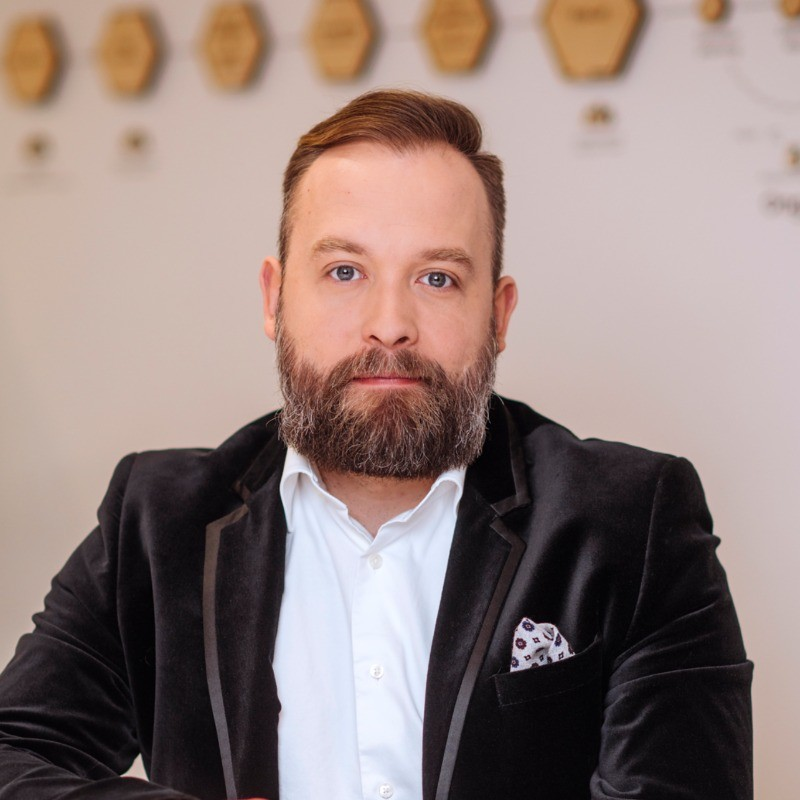Table of content:
- What are end-to-end software development services?
- The end-to-end software development cycle
- Advantages of end-to-end software development
- Costs of E2E software development
In today’s competitive business landscape, leveraging software development has become an essential strategy for growth. If you are looking to propel your business forward, one approach that deserves your attention is end-to-end software development. End-to-end software development streamlines a business’s software development efforts and offers many benefits that can propel it to new heights.
Unlike traditional development approaches that involve juggling multiple vendors and tasks, end-to-end software development simplifies the entire process by placing it in the hands of a single vendor. All aspects of multilayered software development, from conceptualisation to deployment, are seamlessly managed by a cohesive team.
What are end-to-end software development services?
End-to-end software development services encompass the complete lifecycle of developing a software product or solution, from initial planning and design to implementation, deployment, and ongoing support. It involves engaging a single vendor or development team to handle all aspects of the development process, ensuring a cohesive and seamless experience.
If your business wants a software development partner to plan, design, and implement a project, choose vendor providers like Helmes that offer end-to-end (E2E) software development services. Using a company like Helmes eliminates several middle layers and third-party services, which helps optimise workflow efficiency and minimise resources.
In other words, when one development partner takes over all stages of the software development process, businesses will not face any hassle to get the maximum profit. If issues arise during the process, implementing or predicting any changes will be easier if needed.
The only responsible decision businesses and organisations need to make is choosing the right software development partner to produce workable solutions quickly.
Here is how E2E software development works:
- Software development provider forms a team to complete your large and complex project.
- The development process begins with a conceptual discussion and ends with the release of the finished product to the market.
- Businesses pay for the service according to a fixed price or time pricing model.
- Businesses participate in critical discussions and witness intermediate work results.
- After the product launch, the development company provides services with software support and updates.
What type of companies need end-to-end software development?
Any business type can hire an E2E software vendor; however, in our experience, it usually equates to two types.
Startups
When overseeing a startup’s growth, founders often face the critical decision of choosing between freelancers and software service companies to meet their development needs.
A competitive advantage of end-to-end software development for startups is the ability to minimise development costs. Using this approach, startups and small to mid-sized businesses can create software within the budget and minimise the risks of project failure.
Plus, the experienced E2E software development team will take responsibility for all aspects of developing software and test the product idea viability before entering the market.
Enterprises
To maintain a competitive edge, enterprises often require additional expertise to complement their in-house resources. By embracing an end-to-end development life cycle under the guidance of a reputable E2E software vendor team, businesses can unlock the full potential of developing high-quality and comprehensive software products while safeguarding their brand reputation.
You can access a ready-to-work team with a unified and streamlined product development workflow by opting for end-to-end software development services. Thus, it eliminates the need for time-consuming and resource-intensive team recruitment processes, allowing you to focus on your core business objectives more efficiently.
With an experienced and cohesive team at an enterprise’s disposal, large corporations can accelerate their development timelines and ensure a smooth and successful software product launch.
See also: Enterprise Mobile App Development
The end-to-end software development cycle
End-to-end software development implies efficient and well-coordinated work in all its phases. Team members communicate closely with each other, which allows them to stick to the chosen vector and coordinate steps. As a result, it speeds up product development and minimises costs.
Here we would like to share our experience of software development in Integrio. Each project is unique, but regardless of its specifics, an effective workflow consists of the following steps:
Analysis
- We carefully analyse your idea, software requirements, and development scale during the introduction stage.
- Also, at this stage, it is crucial to study the consumers, their pains, desires, fears, and possible objections to the future product. Competitor analysis reveals the market trends and essential features to include in your software.
Planning
- At the planning stage, we discuss different options for solving the tasks with approximate deadlines and budgets. Furthermore, after the chosen path is approved, we create a customer journey map (CJM) to determine what users must do to achieve their goals within your product.
- We also build a Software Requirements Specification (SRS) and analyse non-technical parameters for scalability, security, and performance.
- Depending on the product’s complexity and timing, we form a team, select a technology stack and develop a communication plan.
Prototyping
- Based on your requirements and our research, we created a product prototype with all screens, windows, buttons, and software logic. Here you get a working, non-designed framework because it is vital to approve the mechanics first.
- Prototyping is the best time to make any changes to the project as their fixing will take very little time.
UI/UX Design
- After the prototype was approved, the designer created several screens. At the same time, the copywriter writes the text with the selected tone of voice.
- UI/UX design builds on visual aesthetics and usability. You can evaluate the developed colour scheme, typography, icons, and other graphic elements.
- Edits at this stage are instead a rule rather than an exception. We make changes to the design and copywriting according to your wishes. Moreover, after the style is approved, we scale it to the entire software.
Development
- Coding is the largest and most significant stage of development.
- A front-end developer codes and animates UI/UX design, creating user functionality. It includes buttons, navigation, animations, content organisation, and more.
- The back-end developers deal with the server side of the software. They focus on database storage and organisation, back-end logic, application programming interfaces (APIs), architecture, and servers.
QA Testing
- Helmes uses unit, component, and integration tests to examine its quality.
- Through the tests, our QA engineers check functionality, usability, configuration, compatibility with other software, performance, speed, security, reliability, and other parameters.
- After QA testing, we determine growth areas and correct errors and defects. We repeat the cycle several times until we achieve the desired results.
Launch
- After all QA testing cycles, we make final changes to the code and deploy the system sequentially. This way, we understand the possible vulnerabilities of the product and collect early user feedback. We finalise the solution and ensure the software is ready for use.
- To simplify your interaction with the created solution, we document all necessary information about the product, its functions, and exploitation features. We also provide detailed instructions that future developers dealing with your platform may need.
Maintenance
- The work does not end with the software launch. We continue to support its performance by fixing issues during the maintenance stage. We identify new risks and deal with them in system modules.
- It also includes scaling, updating, and adding new features. Our main task is to do everything to keep the solution fast, convenient, relevant, and progressive for your end users.
Advantages of end-to-end software development
There are many advantages to startups and enterprises choosing E2E development services. Although the reasons are numerous, from our experience, they typically are around the following reasons.
- The cost-effectiveness. Developing software for one company is cheaper than entrusting it to different vendors. It is more profitable than hiring your development staff and paying recruitment and administrative costs. Small businesses will benefit.
- You are dealing with one party. There is only one contract in the end-to-end development process. Therefore, you definitely will not get bogged down in paperwork as if you were entrusting different stages of product creation to various vendors.
- Clear and effective communication. When building a technical product within one team, its members communicate easily and quickly. Being on the same wavelength helps discuss risks, issues, and optimisation ideas on time.
- Better scheduling and planning. Working with one team, you get a detailed plan. The project lead will provide you with the final product goals, the solved clients’ pains, strategies for reducing project risks, and a clear path for creating software.
- Solving issues. Comprehensive work on software helps identify and fix bugs. It speeds up the development process and significantly reduces its cost. Plus, the quicker the software partner discovers issues and bugs in the product’s behaviour, the cheaper it will be to remedy them before the product moves to the subsequent development stages.
- Delivery. End-to-end development simplifies the transition and implementation. UI/UX designers quickly pass the material to front-end developers and give an interface to their back-end colleagues. The QA engineer constantly contacts the developers to identify issues and bring the product to its best performance.
- Flexibility. Any changes and innovations are instantly distributed within the team, and each IT specialist performs their work. In the case of a new strategy, the project manager organises the meeting to coordinate all the actions. With a well-established workflow and experienced teams working on several projects, they can quickly become more flexible when project changes are required.
- Trust and reputation. The software development vendor, aimed at long-term cooperation, tries to do the work on time and with high quality. Moreover, constant communication strengthens trust and connection.
Costs of E2E software development
Two pricing models are commonly used in software development: fixed and hourly pricing.
- The fixed pricing model means the client and service provider agree on a specific set of features that will be delivered at a predetermined cost. For startups seeking strict budget control, this model is particularly appealing. However, it is essential to note that the service provider factors in potential risks when estimating the price, which can impact the overall cost. Additionally, changing course during the project is more challenging. Any alterations require a reassessment of the estimate and scope, potentially leading to increased time and cost.
- The hourly pricing model is the second-most typical example. With this model, you may experience some loss of control over the budget or scope, similar to working with an in-house team where each hour of work incurs a cost. However, this model eliminates risk buffers in the pricing, allowing for quicker course corrections and reduced time spent on estimations and analysis. Whilst you may not achieve all desired features, you can focus on the crucial ones, ensuring the most impactful functionality is delivered.
Choose Helmes as an E2E software development partner
By choosing the Helmes team as your E2E software development partner to build software from ideation, businesses and organisations automatically receive the benefits we provide to our clients through our end-to-end software development services.
Agile
At Helmes, we embrace an agile development approach to ensure that our software solutions meet the ever-changing requirements of our customers. Our team of skilled developers follows an iterative development process that prioritises the most critical features instead of rigidly adhering to a sequential plan. Helmes prioritises customer satisfaction, ensures industry standards compliance, and delivers tangible project results within each short sprint.
The agile methodology allows us to be flexible and responsive to evolving customer needs. Rather than attempting to predict all requirements upfront, we break down the development process into smaller iterations or sprints.
Agile enables us to gather continuous feedback from our clients, incorporate their input, and make necessary adjustments throughout the development cycle. By focusing on the most critical features first, we ensure that the core functionalities are delivered efficiently, meeting the immediate needs of our customers.
Modern tech stacks
Helmes carefully considers the project’s requirements when choosing the tech stack, considering scalability, compatibility, and future-proofing factors.
Helmes stays updated with technological advancements and closely monitors industry trends to identify the most suitable tools, frameworks, and programming languages for each project.
Helmes ensures that our software solutions leverage the latest innovations and best practices by employing modern tech stacks. Thus, it empowers us to develop applications that meet functional requirements and excel in performance, user experience, and security.
Using robust and proven technologies helps us build reliable, scalable, and maintainable software solutions that adapt to changing business needs and evolving technological landscapes.
Unique design system
By developing a unique design system, our team ensures consistency and coherence throughout all pages and components of your product. This unified brand language guides the design process, enabling us to deliver a visually unified and cohesive user experience.
One of the critical advantages of utilising a design system is streamlining the design process. With predefined styles, components, and guidelines in place, our team can work more efficiently, resulting in faster turnaround times and saving you valuable time and money. By eliminating the need to configure these design elements from scratch for each page or component, we can focus on delivering a polished and engaging user interface that aligns seamlessly with your brand identity.
Interface accessibility
At Helmes, we are committed to adhering to design principles that ensure the accessibility of interface design for all users. Our team considers the needs of individuals with hearing impairments and low vision, ensuring that they can effectively use and interact with the interfaces we create.
By prioritising accessibility, we make your products inclusive and enhance their attractiveness and usability, ultimately attracting a broader user base and effectively addressing their core problems.
Data visualisation
Processing complex information can be challenging, especially when users need more prior knowledge or understanding of the data presented on the screen. Data visualisation is crucial in simplifying end users’ perception and comprehension of application data. Helmes prioritises creating intuitive and user-friendly data visualisation solutions that empower users to read and understand complex information effortlessly.
Our approach revolves around developing customisable dashboards that offer interactive infographics and charts. By tailoring the visualisation to your needs, we ensure the data is presented clearly and meaningfully. The interactive nature of our dashboards allows users to explore the data, drill down into specific details, and gain valuable insights without feeling overwhelmed or confused.
Companies that have already worked with Helmes
At Helmes, we understand that sustainable business growth requires a strategic approach. That is why we offer comprehensive tech strategy services to help our clients align their technology initiatives with their overall business objectives. By creating a roadmap for success, we ensure that our software solutions contribute directly to the growth and success of our client’s businesses.
Helmes is a trusted partner for numerous companies seeking top-tier nearshore software development teams in Northern Europe. Our comprehensive range of services includes tech strategy, service design, software development, and data management, all geared towards driving tangible and achievable business growth.
OECD
Helmes has established a collaborative partnership with the OECD Headquarters in Paris, with four dedicated teams working closely with them. Our teams at Helmes are engaged in various projects and areas to support the OECD’s operations effectively.
One of our teams focuses on creating internet applications that cater to the specific needs of the OECD. These applications enhance user experience and provide seamless access to essential information and services.
Airbus
The partnership between Airbus and Helmes in software development outsourcing has been marked by remarkable success. This collaboration extends beyond mere development, as Helmes actively supports the Airbus development team in engaging and expanding the usage of developed solutions.
Kuehne+Nagel
In collaboration with Kuehne + Nagel, Helmes has developed a cutting-edge tool that revolutionises the monitoring and visibility of temperature-sensitive cargo across various modes of transportation. This tool primarily focuses on air and road pharmaceutical shipments, ensuring the utmost care and precision in handling sensitive cargo.
Our solution integrates seamlessly with a cloud-based sensor system, enabling real-time monitoring of temperature conditions throughout the transportation process. By leveraging this technology, Kuehne + Nagel and its customers gain unparalleled visibility into the status of their cargo, ensuring compliance with strict temperature requirements and minimising the risk of spoilage or damage.
The Helmes way for end-to-end software development services
To gain a competitive edge, companies invest resources to keep up with changing consumer demands and meet market needs.
One of the standout advantages of end-to-end software development is its convenience for your business. By encompassing software, hardware, and a skilled team under one roof, you gain access to a complete solution that covers all your needs. Thus, coordinating with different parties eliminates the hassle, ensuring efficient communication and cohesive collaboration throughout the development journey.
Furthermore, E2E development gives you greater control and flexibility over your project. With clearly defined business objectives and predefined steps, you can monitor and steer the development process according to your evolving needs. This level of control enables you to make adjustments, track progress, and accurately predict outcomes, ultimately leading to a smoother and more successful product release.
In essence, end-to-end software development is a comprehensive approach that offers your business a streamlined path to success. By entrusting the entire process to a single vendor, you unlock the benefits of convenience, control, and predictability. Whether you are a startup seeking to bring a groundbreaking product to market or an established company aiming to enhance your digital offerings, E2E development can be the catalyst that propels your business to the forefront of innovation.
Helmes can become your end-to-end software development partner or complement your existing team.
Either way, we deal with an end-to-end software development life cycle to help your business spend minimum efforts and maximise profits using the Helmes way.
Want to know more, then contact us for a chat!
Get in touch




